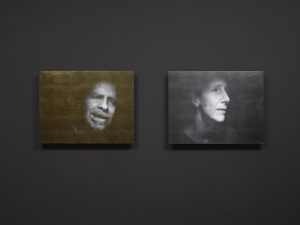Palazzo Bonaparte, a beautiful seventeenth-century building in Rome, has started a new exhibition season, after the closure due to the long period of pandemic, with an exhibition that ensures a restart in style. An exhibition capable of attracting the attention of the general public and younger generations, fulfilling the function of accessibility and inclusiveness that art must nowadays, necessarily possess. Bill Viola is the protagonist of this long-awaited exhibition. Icons of Light, in fact, an exhibition project curated by Kira Perov, the artist’s wife, wants to celebrate the role of the man who, from the beginning of his career, produced art thanks to the new technological media. The undisputed master of video art then, who has always had a special bond with Italy, due not only to his origins, but also to the long artistic association that binds him to some Italian realities such as, for example, Florence and the video art production studio art/tapes/22 for which he worked and the countless exhibitions that over the years presented his works. This time, he exhibits in Rome works that, while ambitiously placing themselves in dialogue with a historical architecture, effectively manage to find their own harmonious dimension, without being inadequate.
Bill Viola declared: “Video and I have grown up together“, alluding to the growth of technological possibilities that guaranteed the progress for his works. But the relationship between these new developments and the maturation of his ideas was very close: the new possibilities went hand in hand with new works, greatly expanding his range of action. When the artist approached video art the possibilities of video were embryonic, however Viola matured the awareness of not only exploring the technical characteristics to create artifacts of reality, but chose to shape the medium to make it an interpreter of reality and human perceptions. In fact, the typical fury of an artist like Wolf Vostell, who denounced and altered the medium of television, does not emerge (the action at the Yam Fluxus Festival in 1963 is an example of this, when he buried a television set, wrapped in barbed wire, on which he ordered a cake with cream to be thrown while a program was being broadcast), nor does the eagerness of Nam June Paik emerge, who, although attracted by the language and the functioning of television, undertook actions of distortion, ridiculing the capacity of reproduction (think of the famous Zen for TV from 1963, a vertically positioned television set that reproduced a thin strip of light).
From Viola’s experimentation springs rather the attention towards man and the most hidden character of his own ego, which is probed through a personal vision that thanks to video is amplified and acquires resonance. His practice shuns the desire to be simulation or reinvention, it does not even seek an aesthetic or aestheticizing dimension and there is no experimentation aimed at taking human possibilities to extremes, rather there is an unavoidable choice that places a dualism at the center, in which the human component, understood as an intimate reflection, prevails. The exhibition at Palazzo Bonaparte wants to shift the attention precisely on this aspect: all the works refer to the most private aspect, where the body and the human figure are placed at the center of the research. There is also a deep reflection on temporality, understood not only as the passage of time but also as change and mutation, death and rebirth. It is also evident in these works that oriental culture, more meditative than the occidental one, has an important influence on Viola: what emerges is that the exhibition demands from the visitor a total devotion at the moment of the visit, calling for an immersive and totalising experience that induces him to abandon certain certainties in order to reach an inner meditation. The most interesting aspect of this exhibition, and therefore of Viola’s art, which is profound and iridescent, is the ability to disprove the aura of coldness that hovers over technological means and to demonstrate that even through these, it is possible to touch and make vibrate the emotional and intimate side of each of us.
Claudia Pansera
Info:
Bill Viola. Icons of Light
curated by Kira Perov
05/03/2022-26/06/2022
Palazzo Bonaparte
Piazza Venezia 5 Roma
T.+ 39 06 87 15 111
 Bill Viola, Unspoken (Silver & Gold), 2001. Black-and-white video projected diptych on one gold and one silver-leaf panel mounted on wall, 62,3 x 193 x 5,7 cm, 35:40 minutes. Performers: John Malpede, Weba Garretson. Photo: Peter Malle
Bill Viola, Unspoken (Silver & Gold), 2001. Black-and-white video projected diptych on one gold and one silver-leaf panel mounted on wall, 62,3 x 193 x 5,7 cm, 35:40 minutes. Performers: John Malpede, Weba Garretson. Photo: Peter Malle
 Bill Viola, Observance, 2002. Color high-definition video on flat panel display mounted vertically on wall 120,7 x 72,4 x 10,2 cm, 10:14 minutes. Performers: Alan Abelew, Sheryl Arenson, Frank Bruynbroek, Carol Cetrone, Cathy Chang, Ernie Charles, Alan Clark, JD Cullum, Michael Irby, Tanya Little, Susan Matus, Kate Noonan, Paul O’Connor, Valerie Spencer, Louis Stark, Richard Stobie, Michael Eric Strickland, Ellis Williams. Photo: Kira Perov © Bill Viola Studio
Bill Viola, Observance, 2002. Color high-definition video on flat panel display mounted vertically on wall 120,7 x 72,4 x 10,2 cm, 10:14 minutes. Performers: Alan Abelew, Sheryl Arenson, Frank Bruynbroek, Carol Cetrone, Cathy Chang, Ernie Charles, Alan Clark, JD Cullum, Michael Irby, Tanya Little, Susan Matus, Kate Noonan, Paul O’Connor, Valerie Spencer, Louis Stark, Richard Stobie, Michael Eric Strickland, Ellis Williams. Photo: Kira Perov © Bill Viola Studio

Born in Reggio Calabria in 1998. In Rome she graduated in Historical-Artistic Studies with an experimental thesis on the artist Nik Spatari. She has written for some magazines and is currently a student of the master’s degree course in Art History. She appreciates art in every declination and loves to tell it.






NO COMMENT